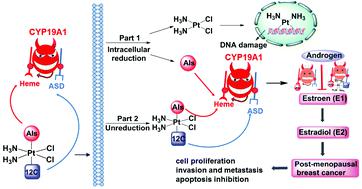当前位置:
X-MOL 学术
›
Inorg. Chem. Front.
›
论文详情
Our official English website, www.x-mol.net, welcomes your
feedback! (Note: you will need to create a separate account there.)
Dual-targeting of the aromatase binding domain of heme and androstenedione by Pt(IV) prodrugs: a new treatment for postmenopausal breast cancer
Inorganic Chemistry Frontiers ( IF 6.1 ) Pub Date : 2022-05-23 , DOI: 10.1039/d2qi00900e Xiao-Meng Liu 1 , Zhe Li 1 , Xin-Rui He 1 , Rui-Ping Liu 1 , Zhong-Ying Ma 1 , Xin Qiao 1 , Shu-Qing Wang 1 , Jing-Yuan Xu 1
Inorganic Chemistry Frontiers ( IF 6.1 ) Pub Date : 2022-05-23 , DOI: 10.1039/d2qi00900e Xiao-Meng Liu 1 , Zhe Li 1 , Xin-Rui He 1 , Rui-Ping Liu 1 , Zhong-Ying Ma 1 , Xin Qiao 1 , Shu-Qing Wang 1 , Jing-Yuan Xu 1
Affiliation

|
The combination of endocrine therapy and chemotherapy is an attractive approach for treating breast cancers. Aromatase inhibitors (AIs) are the first-line drugs for postmenopausal ER-positive breast cancer and adjuvant therapy drugs for early stages of breast cancer. In this paper, we employed the FDA-approved aromatase inhibitor aminoglutethimide (AG) to design and prepare a new class of multi-targeting Pt(IV) prodrugs (aminoplatins 1–3) by utilizing the targeting, estrogen-manipulating, and chemo-sensitizing effects of the aromatase inhibitor. Aminoplatin 3, as a representative, exhibited an enhanced anticancer activity up to 190-fold greater than the parent Pt(II) drug cisplatin, and 3 had less toxicity to normal cells, displaying higher anticancer efficacy and a superior therapeutic index compared to those of cisplatin. Moreover, aminoplatin 3 could enhance intracellular accumulation, induce remarkable DNA damage, inhibit migration and metastasis, and result in S phase cell cycle arrest and apoptosis in ER-positive MCF-7 cells. Besides, molecular docking results showed that 3 simultaneously occupies the heme iron-binding domain and the ASD-binding site of aromatase by a highly efficient dual-binding pattern to aromatase, which further displayed a striking anti-estrogenic effect by significant downregulation of CPY19A1 and ERα in ER-positive MCF-7 cells. Most strikingly, our in vivo anticancer evaluation data also provided evidence that 3 effectively inhibited tumor growth and attenuated kidney toxicity compared to cisplatin in MCF-7 xenografted BALB/c nude mice. Our results suggest that the anticancer activity of aminoplatins is mechanistically distinct from that of the conventional platinum drugs, and modifying platinum drugs with aromatase inhibitors may represent an improved modality for the treatment of advanced postmenopausal breast cancer.
中文翻译:

Pt(IV)前药对血红素和雄烯二酮芳香酶结合域的双重靶向:绝经后乳腺癌的新疗法
内分泌治疗和化学疗法的结合是治疗乳腺癌的一种有吸引力的方法。芳香化酶抑制剂(AIs)是绝经后ER阳性乳腺癌的一线药物和早期乳腺癌的辅助治疗药物。在本文中,我们使用 FDA 批准的芳香酶抑制剂氨基谷胱甘肽(AG) ,利用靶向、雌激素操纵和化学-芳香酶抑制剂的致敏作用。作为代表,氨铂3的抗癌活性比母体 Pt( II ) 药物顺铂高 190 倍,而3与顺铂相比,对正常细胞的毒性较小,显示出更高的抗癌功效和优越的治疗指数。此外,氨基铂3可以增强细胞内积累,诱导显着的 DNA 损伤,抑制迁移和转移,并导致 ER 阳性 MCF-7 细胞的 S 期细胞周期停滞和凋亡。此外,分子对接结果表明,3通过与芳香酶的高效双重结合模式同时占据芳香酶的血红素铁结合域和ASD结合位点,通过显着下调CPY19A1和ER 阳性 MCF-7 细胞中的 ERα。最引人注目的是,我们的体内抗癌评估数据也提供了证据表明与顺铂相比,在 MCF-7 异种移植 BALB/c 裸鼠中,3有效抑制肿瘤生长并减轻肾毒性。我们的研究结果表明,氨基铂的抗癌活性在机制上不同于传统的铂类药物,而用芳香化酶抑制剂修饰铂类药物可能代表了治疗晚期绝经后乳腺癌的一种改进方式。
更新日期:2022-05-23
中文翻译:

Pt(IV)前药对血红素和雄烯二酮芳香酶结合域的双重靶向:绝经后乳腺癌的新疗法
内分泌治疗和化学疗法的结合是治疗乳腺癌的一种有吸引力的方法。芳香化酶抑制剂(AIs)是绝经后ER阳性乳腺癌的一线药物和早期乳腺癌的辅助治疗药物。在本文中,我们使用 FDA 批准的芳香酶抑制剂氨基谷胱甘肽(AG) ,利用靶向、雌激素操纵和化学-芳香酶抑制剂的致敏作用。作为代表,氨铂3的抗癌活性比母体 Pt( II ) 药物顺铂高 190 倍,而3与顺铂相比,对正常细胞的毒性较小,显示出更高的抗癌功效和优越的治疗指数。此外,氨基铂3可以增强细胞内积累,诱导显着的 DNA 损伤,抑制迁移和转移,并导致 ER 阳性 MCF-7 细胞的 S 期细胞周期停滞和凋亡。此外,分子对接结果表明,3通过与芳香酶的高效双重结合模式同时占据芳香酶的血红素铁结合域和ASD结合位点,通过显着下调CPY19A1和ER 阳性 MCF-7 细胞中的 ERα。最引人注目的是,我们的体内抗癌评估数据也提供了证据表明与顺铂相比,在 MCF-7 异种移植 BALB/c 裸鼠中,3有效抑制肿瘤生长并减轻肾毒性。我们的研究结果表明,氨基铂的抗癌活性在机制上不同于传统的铂类药物,而用芳香化酶抑制剂修饰铂类药物可能代表了治疗晚期绝经后乳腺癌的一种改进方式。











































 京公网安备 11010802027423号
京公网安备 11010802027423号